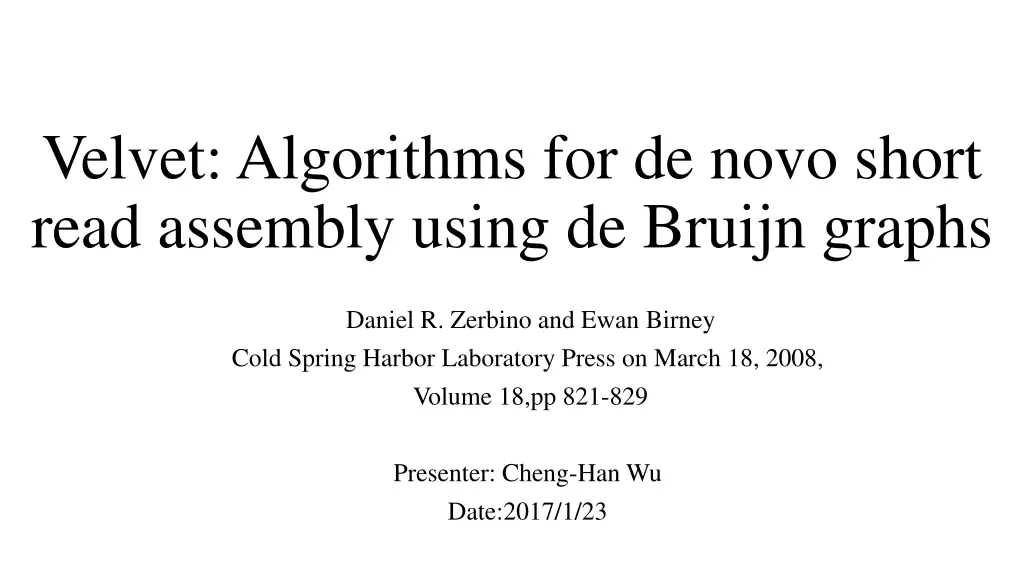
Velvet Algorithms for De Novo Short Read Assembly
"Discover the innovative Velvet algorithms for manipulating de Bruijn graphs in genomic sequence assembly, offering a new approach to leveraging very short reads for generating useful assemblies."
Download Presentation

Please find below an Image/Link to download the presentation.
The content on the website is provided AS IS for your information and personal use only. It may not be sold, licensed, or shared on other websites without obtaining consent from the author. If you encounter any issues during the download, it is possible that the publisher has removed the file from their server.
You are allowed to download the files provided on this website for personal or commercial use, subject to the condition that they are used lawfully. All files are the property of their respective owners.
The content on the website is provided AS IS for your information and personal use only. It may not be sold, licensed, or shared on other websites without obtaining consent from the author.
E N D
Presentation Transcript
Velvet: Algorithms for de novo short read assembly using de Bruijn graphs Daniel R. Zerbino and Ewan Birney Cold Spring Harbor Laboratory Press on March 18, 2008, Volume 18,pp 821-829 Presenter: Cheng-Han Wu Date:2017/1/23
Abstract We have developed a new set of algorithms, collectively called Velvet, to manipulate de Bruijn graphs for genomic sequence assembly. A de Bruijn graph is a compact representation based on short words (k-mers) that is ideal for high coverage, very short read (25 50 bp) data sets. Applying Velvet to very short reads and paired-ends information only, one can produce contigs of significant length, up to 50-kb N50 length in simulations of prokaryotic data and 3-kb N50 on simulated mammalian BACs. When applied to real Solexa data sets without read pairs, Velvet generated contigs of 8 kb in a prokaryote and 2 kb in a mammalian BAC, in close agreement with our simulated results without read-pair information. Velvet represents a new approach to assembly that can leverage very short reads in combination with read pairs to produce useful assemblies.
Contig A critical stage in genome sequencing is the assembly of shotgun reads, or piecing together fragments randomly extracted from the sample, to form a set of contiguous sequences (contigs) representing the DNA in the sample.
de Bruijn graphs TAGAC ATCTG
Velvet parameters ? ? =?(? ? + 1) ? ? + 1 ? ? ? + 1 = ?? ? + 1 ? ? Estimating the expected number ? of times a unique ?-mer in a genome of length ? is observed in a set of ? reads of length ?. We can link this number to the traditional value of coverage, noted C
Construction hash table records the ID of the first read encountered containing that k- mer and the position of its occurrence within that read Another records, for each read, which of its original k-mers are overlapped
Simplification GACTA ACTAG CTAGA GGACT TAGAC AGACT GACTG GACTC ACTCC GACTAGA GGACT TAGACT GACTA GACTCC
Removing bubbles tips tip GACTAGA GGACT TAGACT GACTA GACTCC
Removing bubbles with the Tour Bus algorithm Dijkstra-like BFS : ?(?????)
Effect of coverage on contig length with experimental Streptococcus data.
Complexity Hashing the reads into k-mers Constructing the graph Correcting errors Resolving repeats
